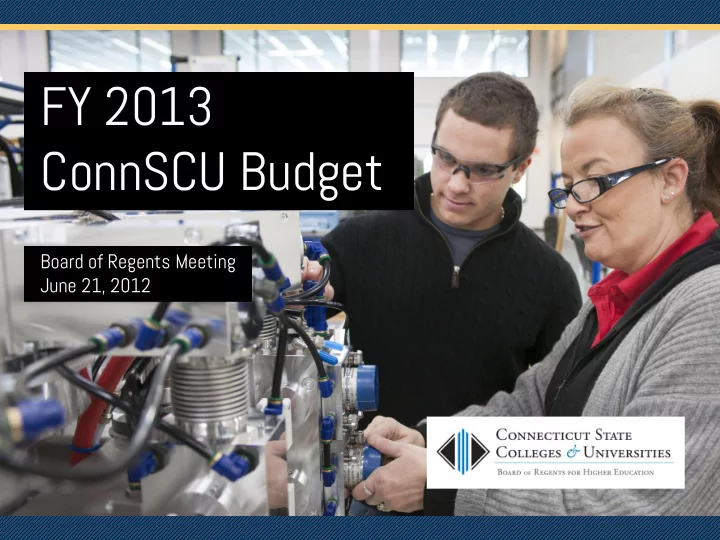

FY 2013 ConnSCU Budget Board of Regents Meeting June 21, 2012
Transitional Context Previo vious us Boards Previous Boards adopted FY 12 budgets and remained in place for 6 months of the year Rolling ling Forwa ward Rolling forward existing budgeting processes from prior systems • Respects statutorily mandated segregation of finances • Bridges a 6 month transition, but • Creates quirks in numbers across the two systems
“Budget Making” in a System System budgets traditionally look different than institutional budgets Syste stem m Role • Focus on revenue: approve tuition and allocate state block grant • Approve spending plan but play a limited role in detailed expenditure decisions Instit titutiona utional Role • Develops detailed expenditure budget Shared ared shortc tcom oming ing of typica ical l budget t formats mats • Limited actionable information • Fails to show relationship between dollars and policy goals
Traditional Approaches (CSU vs. CC) CSU • Campuses present budget proposals to System Office • Tuition based on their own enrollment projections and board approved rate of increase • Block grant allocated by formula as stated in Board policy • Transparency across institutions CC CC • SO develops budgets for campuses based on rollout of prior year (determines block grant allocation), some adjustments (high cost programs), enrollment projections and tuition transfers • An approach, but not a real formula • No transparency across institutions • BOR requested campus budget proposals for FY ‘13 for first time in recent CC system history
Budget Documents The resolution and attachments A1 and A2 Summary financial data as systems (p. 12) CSU/CTC/COSC (not including system office) • Summary financial date as institutions CTC (starts on p. 7) • CSU (p. 10) • COSC (p. 11) • Further detail in Finance Committee materials Key differences across systems Auxiliary: room and board (CSU only) • Grants (CTC only) • Fringe benefits paid by the state (not in CTC) •
The Big Picture: FY ‘12 A year of ma major r financia ncial l change e ends 10.5% decline in state block grant from FY ’11 • First year after loss of federal stabilization funds • Total revenue declined 0.8% • Expenditures increased 4.5% ( Includes 27 th payroll ) • Swing in operating results from +$37M in FY 11 to -$17M in FY 12, • thus reserves used to balance budgets
The Big Picture: FY ‘13 A more stable year begins Slight decline in block grant • 3.5% increase in tuition and fees • Revenues increase by 1. 4% • • Note decline in CC grants Expenditures decline by 0.6% • • Use of reserves for operating subsidy in FY ‘12 does create a challenge in FY ’13 that is bigger than these numbers suggest
Community Colleges Tota tal l expen penses ses show ows s th the bott ttom om line e fo for r a campus, pus, to tota tal l re revenu nues es do not • Total Revenues are adjusted up or down by transfer Differences fferences acro ross s campuse puses s • State Appropriations: operating costs for new facilities: Gateway, Norwalk and Tunxis • Tuition: enrollment projections or fee variations • Flat for all except Gateway (large) and Manchester (small) • Grants
State Universities Less Variation tion • Much less variation across campuses in rate of change Revenu nues es Increase ase • Revenues increase in a range of 2. 4% to 3.2% Slight variation in enrollment projections by campus Expens enses es Increas ase • Expenses increase in a range of 0.9% to 2. 4%
System Office/Reserves System tem Of Office e • elimination of 24 positions; total savings of $5.5 million Reserv erves es • Contingency and undesignated reserves are available to manage the risk of operating deficits • Reserves are adequate for FY 13 risks but decline in CC reserves shows problem with recurring deficits
Transfers across CC’s Longstan standing ding CC allocat cation ion process ss • Longstanding CC allocation process has transferred tuition across campuses to fill gaps Transfer amounts from “donor” institutions • Transfer amounts from “donor” institutions decrease in FY 13 (with one exception) • Suggest that we do an expedited review with donor institutions in July and August to consider interim relief in FY 13 while new allocation approach is adopted for use in FY 14 and beyond
Policy Implications • Holds tuition in range of projected CPI • Keeps spending flat • Prioritizes instruction and student services over administration
Recommend
More recommend